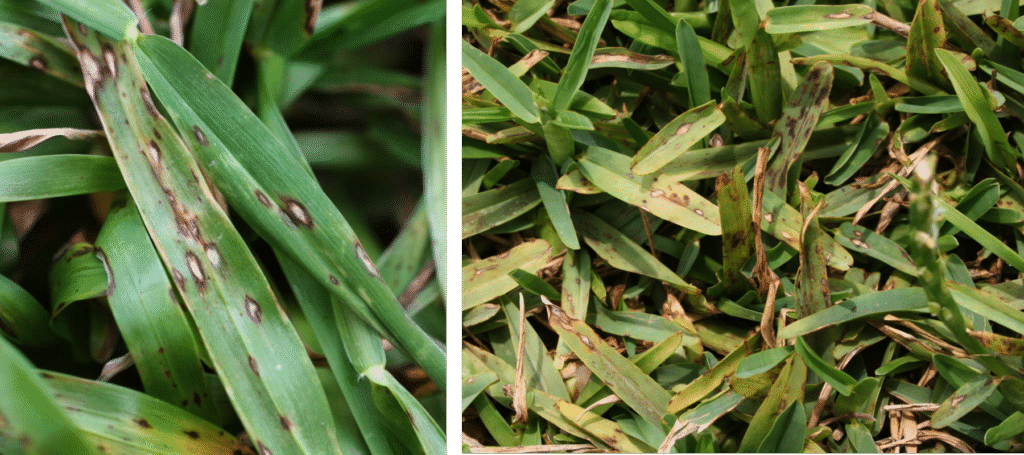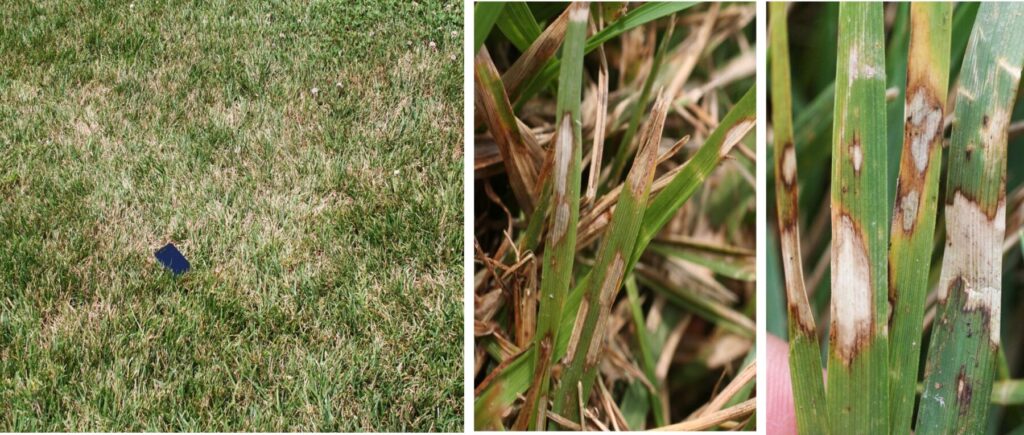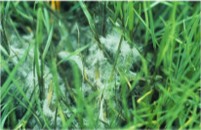Georgia’s summer heat combined with high humidity are favorable conditions for gray leaf spot infection
Gray leaf spot is a fungus disease that affects St. Augustinegrass, perennial ryegrass and tall fescue in Georgia. Hot humid summer weather and high nitrogen levels can make turf susceptible to this disease. The fungus causing the disease is Pyricularia grisea.
Symptoms:The symptoms of gray leaf spot vary depending on the grass cultivar. On St. Augustinegrass, gray leaf spot first appears as small, brown spots on the leaves and stems. The spots quickly enlarge to approximately ¼ inch in length and become bluish-gray and oval or elongated in shape. The mature lesions are tan to gray and have depressed centers with irregular margins that are purple to brown. A yellow border on the lesions can also occur. In cool-season turfgrass, the symptoms are similar to those of melting out

Conditions Favoring Disease: Gray leaf spot is favored by daytime temperatures between 80ºF to 90ºF and night temperatures above 65ºF. It is also found in areas with high nitrogen levels and that are stressed by various factors, including drought and soil compaction. This disease is most severe during extended hot, rainy and humid periods.
Disease Management Tips: Avoid medium to high nitrogen levels during mid-summer. Irrigate turf deeply and as infrequently as possible to avoid water stress. Allow water to remain on leaves for only a short period of time. Reduce thatch. When possible, plant turfgrass that is resistant to gray leaf spot. Avoid using herbicides or plant growth regulators when the disease is active.
Several fungicides are available for gray leaf spot disease management, including those in the chemical families of the QoI’s, benzimidazoles, demethylation inhibitors (DMI), carboxamides, and nitriles. These materials should be applied with at least 2 gallons of water per 1000 sq. ft. for a complete coverage of the turfgrass canopy. Consult the 2025 Georgia Pest Management Handbook https://extension.uga.edu/publications/detail.html?number=SB28-33 or the 2025 Turfgrass Pest Control Recommendations for Professionals https://turf.caes.uga.edu/content/dam/caes-subsite/georgiaturf/docs/pcrp2024/2024_Disease_Control.pdf for proper fungicide selection and usage. Read the label and follow proper guidelines.
For more information or photos of gray leaf spot
Diagnosing, preventing, and managing brown patch (caused by Rhizoctonia solani) and Pythium blight (caused by Pythium spp).
These diseases are often the most serious summer diseases on cool season grasses in Georgia, especially on tall fescue in landscape settings.
Brown patch (on tall fescue) can cause a foliar blight, which results in necrotic leaves and circular brown patches up to 4-5 ft in diameter. High soil and leaf canopy humidity, and high temperatures increase disease severity. Higher than recommended rates of nitrogen in the spring promotes disease. Management options includes avoiding nitrogen application when the disease is active, avoiding infrequent irrigation and allowing the foliage to dry, mowing when grass is dry, ensure proper soil pH, thatch reduction, and improve soil drainage. Several fungicides are available for brown patch disease management, including fungicides in the chemical families of QoI’s, benzimidazoles, demethylation inhibitors (DMI), Succinate Dehydrogenase Inhibitors, carboxamides, phenylpyrrole, nitriles among others. Consult the 2025 Georgia Pest Management Handbook https://extension.uga.edu/publications/detail.html?number=SB28-33 or the 2025 Turfgrass Pest Control Recommendations for Professionals https://turf.caes.uga.edu/content/dam/caes-subsite/georgiaturf/docs/pcrp2024/2024_Disease_Control.pdf for proper fungicide selection and usage. Read the label and follow proper guidelines.

Pythium blight has the potential to quickly cause significant damage to turfgrass. The disease starts as small spots, which initially appear dark and water-soaked. Affected turfgrass dies rapidly, collapses, and appears oily and matted. White, cottony mycelia may be evident early in the morning. The disease is driven by hot-wet weather, which correlates with an increased stress on the turf. Similar environmental and cultural factors that encourage brown patch also promote Pythium. Therefore, cultural practices for control of brown patch will also help to minimize Pythium blight development. A correct diagnosis is important because Pythium control requires specific fungicides.
Several fungicides are available for Pythium disease management. Consult the 2025 Georgia Pest Management Handbook https://extension.uga.edu/publications/detail.html?number=SB28-33 or the 2025 Turfgrass Pest Control Recommendations for Professionals https://turf.caes.uga.edu/content/dam/caes-subsite/georgiaturf/docs/pcrp2024/2024_Disease_Control.pdf for proper fungicide selection and usage. Read the label and follow proper guidelines.

For more information on Brown patch and Pythium visit